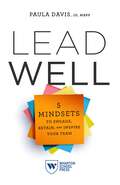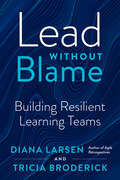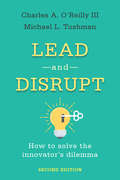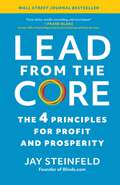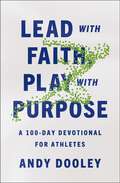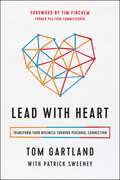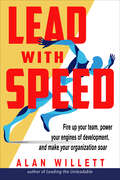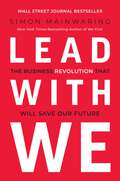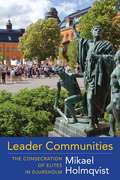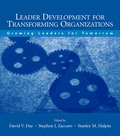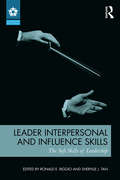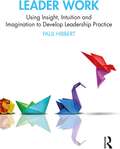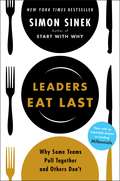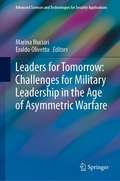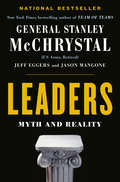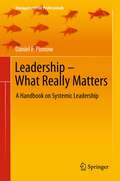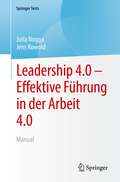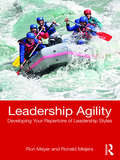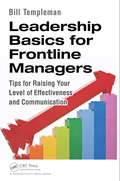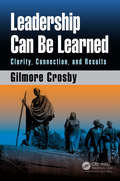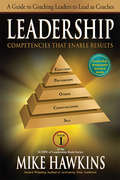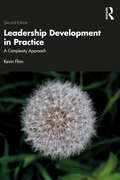- Table View
- List View
Lead Well: 5 Mindsets to Engage, Retain, and Inspire Your Team
by Paula DavisA holistic, research-backed framework to future-proof your leadership and unlock the full potential of your teamIn the wake of the pandemic and on the cusp of the generative AI revolution, the world of work has undergone a seismic shift. Chronic stress, burnout, and employee disengagement have reached crisis levels, and leaders are struggling to keep their teams motivated and inspired amid relentless change and uncertainty. Conventional management approaches are no longer sufficient, demanding a new leadership framework to address the root causes of these challenges.To meet this moment, Lead Well: 5 Mindsets to Engage, Retain, and Inspire Your Team provides a timely and practical blueprint for a new era of leadership. Drawing on extensive research and workshops with thousands of leaders, Paula Davis, CEO and founder of the Stress & Resilience Institute and author of Beating Burnout at Work, offers a transformative approach to building high-performing teams that can adapt and grow, even in the face of relentless change.Lead Well offers actionable tools and insights to help you and your team today:+ Discover the 5 Lead Well mindsets that can transform your team’s well-being at work;+ Explore research-backed strategies to foster a greater sense of purpose, meaning, and values alignment at work;+ Gain techniques to improve workload management, work-life integration, and sustainable productivity;+ Develop skills to build team cohesion and a culture of trust and support;+ Cultivate practices that boost systemic resilience and help teams adapt to disruption; and+ Implement Tiny Noticeable Things (TNTs) that can be quickly adopted by teams.Davis’s first book, Beating Burnout at Work, addressed individuals and teams experiencing significant stress. This new book offers a method for addressing the factors that can lead to counterproductive stress and disengagement.Whether you’re a seasoned leader or an emerging manager, Lead Well provides a holistic, research-backed framework to future-proof your leadership and unlock the full potential of your team. Navigating today’s turbulent work landscape has never been more critical—or more achievable.
Lead Without Blame: Building Resilient Learning Teams
by Diana Larsen Tricia BroderickA detailed framework for leaders to move past outdated workplace blame and shame strategies to cultivate resilient teams capable of facing adversity and setbacks confidently.Workplace finger-pointing stifles creativity, reduces productivity, and limits psychological safety. Although no one sets out to be judgmental, learning new habits is hard. Two experienced leadership and agilists coaches share a road-tested leadership model that continuously embraces humility and failure as part of the growth process to deliver results.By facilitating blame-free retrospective meetings, leaders chart a productive path forward. They amplify three essential motivators of purpose, autonomy, and co-intelligence within their team. Layered on with four resilience factors: inclusive collaboration, transparent power dynamics, collaborative learning, and embracing conflict. After applying these strategies, learning leaders will help their teams and themselves become more resilient and better equipped to handle any unexpected and challenging tasks that comes their way.
Lead and Disrupt: How to Solve the Innovator's Dilemma, Second Edition
by Michael L. Tushman Charles A. O’Reilly IIIFully revised, this second edition offers a proven strategy for using ambidexterity to build discontinuous growth for mature organizations, and the flexibility to adapt in fast-changing environments. Why do successful firms find it so difficult to adapt in the face of change – to innovate? In the past ten years, the importance of this question has increased as more industries and firms confront disruptive change. The pandemic has accelerated this crisis, collapsing the structures of industries from airlines and medicine to online retail and commercial real estate. Today, leaders in business have an obligation not only to investors but to their employees and communities. At the core of this challenge is helping their organizations to survive in the face of change. The original edition summarized the lessons that the authors as researchers and consultants had learned over the previous two decades. Since then, they have continued to work with leaders of organizations around the world confronting disruptive change. With updates to every chapter, including new examples and analysis, this fully revised edition incorporates the lessons and insights that the authors have gained in the past five years. Two new chapters critically examine the role of organizational culture in promoting or hindering ambidexterity and its underlying fundamental disciplines. Using examples from firms such as Microsoft, General Motors, and Amazon, O'Reilly and Tushman illustrate how leaders can align their organization's cultures to fit the needed strategy, and how ideation, incubation, and scaling approaches, when used altogether, can successfully develop new growth businesses.
Lead from the Core: The 4 Principles for Profit and Prosperity
by Jay SteinfeldWALL STREET JOURNAL BESTSELLER Jay Steinfeld, Ernst & Young Entrepreneur of the Year and the founder and CEO of Blinds.com (acquired by Home Depot), never planned to create the biggest online window blinds retailer in the world. Against all odds to succeed, Steinfeld&’s journey in business included failed acquisitions, partnerships gone wrong, perpetual self-doubt, deaths in his family, budget-limited guerilla marketing, corporate buy-outs, brutal market competition, and a complete disruption of industry leaders, including Amazon and big-box retailers. To build something meaningful like Steinfeld, you need to do more than dream about it. You need to Lead from the Core. Learn Steinfeld&’s &“Four Es&”—a set of guiding principles that help overcome any obstacle to your organization&’s success: Evolve Continuously, Experiment Without Fear of Failure, Express Yourself, and Enjoy the Ride. In these pages, you&’ll also learn specific, actionable tactics, including: How to start a business with little money and experience Ways to avoid the early failure that plagues many businesses Strategies to scale beyond the startup phase Exactly how to communicate with boards and investors Proven lessons to attract potential acquirers of your company Told with humor and heart, Lead from the Core is not just a roadmap to make your company a resounding success. It&’s a masterclass for leaders looking to prevent costly business mistakes, no matter where you are in your journey.
Lead from the Heart: Transformational Leadership for the 21st Century
by Mark C. CrowleyIf you're a leader in America, you've got a big problem. More than half of all workers hate their jobs. In fact, job satisfaction and employee engagement have been declining for twenty-two straight years. One hundred years ago, a job and a paycheck kept workers satisfied. Now, pay barely makes the list. Employees' needs have evolved dramatically. But our leadership practices have failed to keep up. In Lead From The Heart, Mark C. Crowley presents compelling new evidence that the solution leaders need lies in the last place traditional business would seek it: the human heart. Twenty-first-century employees need to feel... valued, respected, developed, and cared for. Their work has to matter. Recent scientific discoveries tell us that it's the heart, and not the mind, that drives human performance and achievement. Drawing on decades of experience as a senior leader for regional and national financial institutions, Mark C. Crowley offers proof that leaders who intentionally engage the hearts of their employees will be rewarded with uncommon (and highly sustainable) performance and achievement.
Lead with Faith, Play with Purpose: A 100-Day Devotional for Athletes
by Andy DooleyAs an athlete, you train your body and mind to be ready for competition. But what about your soul? Lead with Faith, Play with Purpose is your guide to exercising your faith, with Andy Dooley as your trainer.As a professional athlete turned pastor--and a passionate leader, Seattle Seahawks in-game host, social media influencer, and fitness trainer--Andy Dooley knows all about sports and what it takes to be a Christian on and off the field, court, or wherever you may play. A 100-day devotional written to encourage and guide athletes of any age, level, or sport, Lead with Faith, Play with Purpose is just what you need to integrate your faith into what you love to do--play your sport.Let Dooley be your spiritual trainer and coach you to:Become a better teammate in four simple stepsDiscover effective ways to handle stress before a competitionIdentify how God is working through your sport to make you more like himUnderstand and embrace your calling as a Christian who is also an athletePhysical training has value for our lives here on earth, yet it holds zero weight for the eternal. If you learn to be tenacious about living a godly life now as you also strive to become a better athlete and teammate, you'll change the trajectory of your life.
Lead with Heart: Transform Your Business Through Personal Connection
by Patrick Sweeney Tom GartlandIf you want your company to thrive, you need to break one of the oldest unwritten rules of leadership. Leaders in nearly every industry have learned to keep a professional "distance" between themselves and the people who report to them—to avoid getting too close or too personal. This unwritten rule of leadership is pervasive and quietly destructive, and, little by little, keeping ourselves at arm's length destroys trust, collaboration, and the very fabric of organizations. When Tom Gartland became president of Avis Budget Group, North America, he wanted the corporate culture to become more "open and connected"—so he started with himself. His message was "business is personal—very personal." As he grew closer and connected more with those he was leading, he became a more effective leader, and those around him were inspired to create unprecedented results. Tom found that when we truly open up and care about the people we work with, we can transform organizations into sanctuaries where people feel a deep connection to one another, a profound sense of being part of an important mission, and extraordinary engagement in their work. The result? Employees who feel valued generate exceptional profits. After applying this business philosophy at Avis, not only did Tom see an increase in employee morale, he also saw a significant increase in the company's bottom line. In Lead with Heart, Tom provides an unconventional approach to business leadership, including advice and strategies on how to open yourself up as a leader, recognize potential in your employees, and increase employees' trust in you and the company. Lead with Heart is the revolutionary leadership book that will help managers and employees at all levels grow their businesses by connecting, honestly and meaningfully, with the people they lead.
Lead with Speed: Fire Up Your Team, Power Your Engines of Development, and Make Your Organization Soar
by Alan WillettThe speed of the business is the speed of the leader. It’s time to up your game. One of the most important questions a leader can ask themselves is: “How do I get my teams, my organization to move faster?”That is the challenge that all leaders face. This challenge grows more intense every day. Lead with Speed is the answer. This problem of speed is often disguised by other symptoms, such as “my projects cannot make an accurate prediction of when they will be done” or the stated need of “my teams need to take more risks.” The real need is not reckless risk-taking that will lead to even more problems and finishing even later. The real need is for speed.An organization can only move as quickly as its leaders. Lead with Speed shows you how to get your ideas, plans, and needs disseminated quickly from the top down. Innovation, or genius, is 1 percent inspiration and 99 percent perspiration. Alan Willett provides a comprehensive guide on how to sweat faster. You will learn how to:Develop the mind-set required for leading with speed•Discern the critical differences between slow and fast projects•Notice what you as a leader need to do to create those differences•Create a targeting system for speed•Get whole groups of people working together to create organizational speed•Lead the exceptional few to be the catalyst for accelerating your organization
Lead with We: The Business Revolution That Will Save Our Future
by Simon MainwaringWALL STREET JOURNAL BESTSELLER 2022 NATIONAL INDIE EXCELLENCE AWARDS FINALIST — BUSINESS: GENERAL 2022 AXIOM BUSINESS BOOK AWARD GOLD MEDALIST — LEADERSHIP "Critically important reading as our economy struggles to recover the pandemic's deleterious economic impact that is currently compounded by supply chain issues and the beginnings of an inflationary spiral." —The Midwest Book Review "Provides concrete steps leaders and employees can take to thrive in today&’s marketplace, where taking a stand on something important to your customers can become a competitive differentiator." —Forbes Discover an urgent prescription for a new business paradigm—one that better serves humanity and the planet. The global coronavirus pandemic has thrown into stark relief how &“business as usual&” is no longer serving us. The economic, business, and environmental models of the past do not reflect our current realities. And for our economy—for us—to survive, we need nothing less than a seismic shift in the way we do business. Enter Simon Mainwaring, New York Times-bestselling author and founder and CEO of We First. A decade ago, he showed how business leaders and consumers could use social media to build a better world in We First. Now, after decades of research and field experience at the vanguard of the world&’s most successful brand revolutions, he provides in Lead With We a blueprint for doing business better in today&’s challenged world. By leading with &“we&”—putting the collective above the individual, holding the sum above the parts, and emphasizing the importance of the role that everyone plays—you can not only help solve the escalating challenges of today but also unlock extraordinary growth for your business, and abundance on our planet. Timely and compelling, this book&’s message is simple: The future of profit is people&’s purpose, aligned. Lead With We not only examines why we must all conduct business differently in order to grow in today&’s market, but provides the how—concrete steps any reader, wherever they find themselves in the business hierarchy, can take toward success.
Leader Communities: The Consecration of Elites in Djursholm
by Mikael HolmqvistAll around the world there are elite suburban communities: Palo Alto, California, and Greenwich, Connecticut, in the U.S.; Paris's Neuilly; and Oxshott outside London. These wealthy suburbs are home to the economic and social elites who work in the world's global cities. Stockholm's suburb Djursholm is one such place. It is full of large houses, winding lanes, and is surrounded by a beautiful landscape. Its residents prize physical fitness, healthy eating, fine art, and education. Despite Sweden's reputation for egalitarianism, Djursholm is representative of global mechanisms of privilege and its perpetuation.Leader Communities is the sociologist Mikael Holmqvist's term for places like Djursholm: the communities where elites choose to live, socialize with other elites, and, most importantly, form families and raise their children into future elites. Such neighborhoods consecrate inhabitants into leaders—that is, they offer their residents a social environment that imbues people with a sense of social and moral elevation. By idealizing their residents, leader communities' allegedly superior lifestyle and character act as a principle of distinction and legitimation. Holmqvist calls this a consecracy—a society that leads by means of its aura, brightness, and radiance, allowing the privileged to pose as a moral vanguard. Leaders are made—not born—by the culture, history, traditions, ceremonies, rituals, and institutions of the place. Based on a comprehensive five-year ethnographic study, this book is a community study of Djursholm in which the author ventures inside the world of the elite to explore the mechanics of social interaction and power. Leader Communities introduces vital new concepts to the study and understanding of contemporary elites and offers a troubling analysis of the moral, social, and political consequences of their aspirations to lead societies.
Leader Development for Transforming Organizations: Growing Leaders for Tomorrow (Applied Psychology Series)
by David V. Day Stephen J. Zaccaro Stanley M. HalpinThis book examines numerous topic areas that are considered to be especially relevant for making a strategic leader development investment. The topics covered are areas that have theoretical and empirical connections to important aspects of growth, change, adult development, and underlying abilities, skills, and competencies needed to lead effectively in times of great complexity. In addition, these are investment areas identified by the U.S. Army--a world-class organization faced with the need for radical transformation--as particularly relevant for success and survival. This book identifies key concerns in developing leaders and leadership, and in transforming organizations to better meet the challenges of a complex world.There are two aspects of this book that distinguish it from the numerous existing volumes on leadership in the scholarly and popular-press literatures. Most important, the overarching focus of the present book is on development. There are many offerings on the topic of leadership, but relatively few that focus on leader development--especially from a scholarly, academic perspective. Also, this volume offers a unique perspective in examining those underlying psychological competencies and processes that are viewed as especially relevant for leader development.The chapters that are collected in this edited volume were originally commissioned by the U.S. Army Research Institute as "white papers" to better help Army officers and researchers understand important issues in leader development. The present organization of the papers is around four central themes: a) Accelerating Leader Development, b) Cognitive Skills Development, c) Developing Practical and Emotional Intelligence, and d) Enhancing Team Skills.
Leader Interpersonal and Influence Skills: The Soft Skills of Leadership (ISSN)
by Ronald E. RiggioThis edited volume explores different models, conceptualizations, and measures of leader interpersonal and influence "soft skills" that are so necessary for effective leadership. These include the communication skills, persuasion skills, political savvy, and emotional abilities used by leaders to inspire, motivate, and move followers toward the accomplishment of goals. The book emanates from the two-day-long 21st Kravis-de Roulet leadership conference, which brought together top scholars working in this area. The intent of the conference and this edited volume is to increase understanding of the interpersonal and influence skills, or "soft skills," of the leader, to highlight state-of-the-art research on the topic, and to provide clear, research-based guidelines for the development of leader skills.Chapter authors are recognized experts in their respective areas, and each section of the book will be introduced by an editor-authored chapter reviewing the specific topic area in brief.
Leader Interpersonal and Influence Skills: The Soft Skills of Leadership (Leadership: Research and Practice)
by Ronald E. Riggio Sherylle J. TanThis edited volume explores different models, conceptualizations, and measures of leader interpersonal and influence "soft skills" that are so necessary for effective leadership. These include the communication skills, persuasion skills, political savvy, and emotional abilities used by leaders to inspire, motivate, and move followers toward the accomplishment of goals. The book emanates from the two-day-long 21st Kravis-de Roulet leadership conference, which brought together top scholars working in this area. The intent of the conference and this edited volume is to increase understanding of the interpersonal and influence skills, or "soft skills," of the leader, to highlight state-of-the-art research on the topic, and to provide clear, research-based guidelines for the development of leader skills.Chapter authors are recognized experts in their respective areas, and each section of the book will be introduced by an editor-authored chapter reviewing the specific topic area in brief.
Leader Work: Using Insight, Intuition and Imagination to Develop Leadership Practice
by Paul HibbertLeader Work offers an accessible and engaging introduction to the power of reflection to support leaders in their development and professional practice. The book does not present a tick-box toolkit to being a better leader, instead it provides the prompts and deeper reflexive space for leaders to consider their own self-development.Written by a leading management researcher and consultant, the book draws on reflexive practice, but goes beyond this method to guide the reader on how to consider both inward and outward work, and provides useful suggestions for application. The inward work involves developing our knowledge of ourselves, our capabilities and our limitations through self-examination and connecting with others, and so building up our capacity for judgment, and gaining confidence in using intuition and imagination thoughtfully in situations of complexity and uncertainty. The outward work involves learning to express a leader identity that is both true to ourselves and recognized by relevant groups and the organizations in which we work, so that we are trusted to help navigate and narrate a path through uncertainty.This book has been written for leaders and would-be leaders looking to develop and shape their practice, as well as scholars studying and teaching leadership classes.
Leader to Leader
by Frances HesselbeinThis volume will spark ideas, open doors, and inspire all those who face the challenge of leading in an ever-changing environment.
Leaders Eat Last: Why Some Teams Pull Together and Others Don't
by Simon SinekThe New York Times bestseller by the acclaimed, bestselling author of Start With Why and Together is Better. Now with a new chapter on leading millennials, based on Simon Sinek's viral video "The Millennial Question" (150+ million views).Imagine a world where almost everyone wakes up inspired to go to work, feels trusted and valued during the day, then returns home feeling fulfilled. This is not a crazy, idealized notion. Today, in many successful organizations, great leaders create environments in which people naturally work together to do remarkable things. In his work with organizations around the world, Simon Sinek noticed that some teams trust each other so deeply that they would literally put their lives on the line for each other. Other teams, no matter what incentives are offered, are doomed to infighting, fragmentation and failure. Why?The answer became clear during a conversation with a Marine Corps general. "Officers eat last," he said. Sinek watched as the most junior Marines ate first while the most senior Marines took their place at the back of the line. What's symbolic in the chow hall is deadly serious on the battlefield: Great leaders sacrifice their own comfort--even their own survival--for the good of those in their care. Too many workplaces are driven by cynicism, paranoia, and self-interest. But the best ones foster trust and cooperation because their leaders build what Sinek calls a "Circle of Safety" that separates the security inside the team from the challenges outside.Sinek illustrates his ideas with fascinating true stories that range from the military to big business, from government to investment banking.
Leaders for Tomorrow: Challenges for Military Leadership in the Age of Asymmetric Warfare (Advanced Sciences and Technologies for Security Applications)
by Marina Nuciari Eraldo OlivettaSince the end of bipolarism, the concept of asymmetric warfare, and of asymmetric conflict in general, has been increasingly applied with regard to armed forces activities and tasks. This book presents the findings of comparative empirical research conducted in selected military units by a group of distinguished experts on military organization, who hail from the eight participating countries: Bulgaria, Cameroon, Denmark, Finland, Italy, Lithuania, the Philippines and Spain.It discusses remarks made by military leaders with extensive experience in the field regarding current doctrines on military leadership and their applicability in the field, as well as proposals and suggestions for new directions.“It is a complex relation, always based on respect and politeness, but often with mismatched interests.” (Army Colonel).“It makes you realize that there is a cultural gap. You must firstly understand who you are going to relate to, and the culture of these people, and then try to establish a certain kind of relationship. Often the platoon commander states his objective and must try to establish a relationship, contact with the village chief.” (Army Lieutenant, Platoon Commander).“[In Afghanistan] We had meals with the locals, sometimes the food didn’t taste good, but you had to eat it if you wanted to be welcomed back again” (Army Captain, Company Commander).These are just some of the many voices stemming from the ground in diverse international asymmetric conflict theatres (in Iraq, in Kosovo, in Afghanistan…), comments by military officers, commanders at different hierarchical levels, asked to reflect on their experiences as military leaders in crisis response operations.Military professionals, and military leaders in particular, perceive themselves as facing ambiguous situations that require an update in their professional training, and new skills to confront unexpected and unpredictable factors. Drawing on lived experiences, the book offers insights into what a new kind of leadership means when leaders have to cope with diverse and unclear missions. It also addresses leadership styles and behaviours, as well as individual adaptive behaviours on the part of military leaders, with special reference to middle and middle-high level ranks, such as captains, majors and colonels.Given its scope, the book will appeal not only to military professionals and military affairs scholars and experts, but also to readers interested in gaining a better understanding of the challenges that international expeditionary units are facing in crisis areas around the globe.
Leaders: Myth and Reality
by Stanley McChrystal Jeff Eggers Jay MangoneLeadership is not what you think it is--and it never was.Stan McChrystal served for thirty-four years in the US Army, rising from a second lieutenant in the 82nd Airborne Division to a four-star general, in command of all American and coalition forces in Afghanistan. During those years he worked with countless leaders, at every level of effectiveness, and pondered an ancient question: “What makes a leader great?” He came to realize that there is no simple answer. In this follow-up to his bestsellers My Share of the Task and Team of Teams, McChrystal profiles thirteen famous leaders from a wide range of eras and fields—from corporate CEOs to politicians and revolutionaries. He uses their stories to explore how leadership works in practice and to challenge the myths that complicate our thinking about this critical topic. With Plutarch’s Lives as his model, McChrystal looks at paired sets of leaders who followed unconventional paths to success. For instance. . .· Walt Disney and Coco Chanel built empires in very different ways. Both had public personas that sharply contrasted with how they lived in private. · Maximilien Robespierre helped shape the French Revolution in the eighteenth century; Abu Musab al-Zarqawi led the jihadist insurgency in Iraq in the twenty-first. We can draw surprising lessons from them about motivation and persuasion. · Both Boss Tweed in nineteenth-century New York and Margaret Thatcher in twentieth-century Britain followed unlikely roads to the top of powerful institutions. · Martin Luther and his future namesake Martin Luther King Jr., both local clergymen, emerged from modest backgrounds to lead world-changing movements. Finally, McChrystal explores how his former hero, General Robert E. Lee, could seemingly do everything right in his military career and yet lead the Confederate Army to a devastating defeat in the service of an immoral cause. Leaders will help you take stock of your own leadership, whether you’re part of a small team or responsible for an entire nation.
Leadership - What Really Matters: A Handbook on Systemic Leadership
by Daniel F. PinnowWhat does really matter for daily leadership? How would a good and effective manager be characterized? Daniel F. Pinnow describes in a very illustrative way the essentials of collaborating with people in the business environment. This standard reference book exists as a 4th edition in German and is also available in Chinese. It provides a comprehensive and easy-to-understand overview over the most important leadership approaches in theory and practice. The credo of the author is: Leadership is an art of creating a world where others would love to join in.
Leadership 4.0 – Effektive Führung in der Arbeit 4.0: Manual (SpringerTests)
by Jens Rowold Julia NoggaWie können Führungskräfte in der digitalen Arbeitswelt ihre Mitarbeitenden bzw. Arbeitsteams motivieren und an die Organisation binden? Welche führungsbezogenen Verhaltensweisen sind dabei unverzichtbar? Welche Instrumente können Personaler*innen nutzen, um Führungskräfte auf die neuen Herausforderungen der Arbeitswelt 4.0 vorzubereiten? Hier erhalten Sie den ersten Fragebogen der Führungsverhalten in digitaler Umgebung messen kann.Wie von der Praxis benötigt, kombiniert dieses Modell eine Vielzahl effektiver Verhaltensweisen, woraus ein neuer Führungsstil entsteht. Dieser beinhaltet dabei vier Facetten von Verhaltensweisen, die nachgewiesenermaßen relevant für den Erfolg von Führungskräften und ihre jeweilige Organisation sind.Dazu zählen:a) die Partizipationb) die Arbeitsgestaltung (räumliche, zeitliche und technologisch)c) die individuelle Entwicklungd) die TeamentwicklungDie vier Facetten von bilden eine angemessene Grundlage, aktuelle Aufgaben und Probleme der organisationalen Praxis zu bewältigen. Durch die veränderten Arbeitsbedingungen der Arbeit 4.0 ergeben sich zahlreiche Herausforderungen, mit denen Führungskräfte in Unternehmen konfrontiert sind. Die Grenzen zwischen Erwerbsarbeit und privatem Freizeitbereich verwischen zunehmend, sodass Mitarbeitende einerseits mehr Partizipation, andererseits mehr subjektiv erlebte Relevanz in ihrem Job erleben möchten. Deswegen müssen Führungskräfte ihren Mitarbeitenden die Möglichkeit geben, sich an Entscheidungen im Unternehmen zu beteiligen. Dies kann erfolgen, indem Führungskräfte ihren Mitarbeitenden ermöglichen, Einfluss auf Arbeitsinhalte zu nehmen oder Prozessinnovationen anzustoßen.Da ein Fachkräftemangel auf dem Arbeitsmarkt herrscht, steigt die Bedeutung, kompetente Mitarbeitende im Unternehmen zu halten. Wenn es darum geht, die emotionale Verbundenheit der Mitarbeitenden mit dem Unternehmen zu fördern, spielen Führungskräfte eine wichtige Rolle. Dass Führungskräfte dieses affektive Commitment bei den Mitarbeitenden hervorbringen können, ist von empirischen Studien belegt. Diesbezüglich ist auch die Arbeitszufriedenheit der Mitarbeitenden von Relevanz, denn viele Studien bestätigen den Zusammenhang von Führung und Arbeitszufriedenheit.
Leadership Agility: Developing Your Repertoire of Leadership Styles
by Ron Meyer Ronald MeijersLeadership is about influencing others to move in a certain direction and there are many ways of achieving this influence. Each of these leadership styles has its inherent qualities and pitfalls, and will be more suited to specific people and different circumstances. The more leaders understand their preferred leadership styles and are able to flexibly switch to the most suitable style given the situation, the more effective they will be. This book maps out ten sets of opposite leadership styles, giving readers the possibility to understand the strengths and weaknesses of both sides, and to identify their own current preference. The ten leadership style dimensions cover the full range of leadership roles, from the leader as coach (interpersonal leadership), to the leader as organizer (organizational leadership), as strategist (strategic leadership), as sense-maker (leadership and mission) and as role model (leadership and self). Readers are invited to draw up their own leadership development plans, which is supported by an interactive App. Readers are also challenged to reflect on how they would approach a number of cases, after which they can go to an interactive web-forum to read how others have responded and engage in a discussion with them. Leadership Agility is a useful tool for practitioners in the corporate world as well as business students and emerging leaders.
Leadership Basics for Frontline Managers: Tips for Raising Your Level of Effectiveness and Communication
by Bill TemplemanThis book is classified and organised into three major headings: personal effectiveness, leadership, and communication. It focuses on interpersonal management skills and explains what it takes to improve how frontline managers and supervisors communicate and relate to their employees and customers.
Leadership Can Be Learned: Clarity, Connection, and Results
by Gilmore CrosbyLeadership is poorly understood because human systems are poorly understood. Like the "flat earth" theory of old, modern work culture is limited by a paradigm in which problems are understood as "clashes of personality,"' and blame is directed at the superficial level of individuals, groups, and structure. Leadership Can Be Learned: Clarity, Connection, and Results charts the course to a new paradigm of leadership and systems and how to leverage the relationship between the two. Leadership can be learned because it is a combination of art and science. Ultimately, high- performance culture and high-performance leadership mirror each other, and leaders must use their own unique strengths to foster both. Gilmore Crosby guides the reader by breaking the topic into four powerful sections. The first focuses on the transformational leadership model of Dr. Edwin Freidman, the second describes the systems theory from which that leadership model emerged, the third offers a unique exploration of emotional intelligence and critical interpersonal skills related to leadership, and the fourth and final section applies all the previous sections to attaining organizational results. This book: Delivers a clear how-to guide for leading organizations to higher performance Helps each reader understand, respect, and rise above their own authority issues Conveys a proven approach to life-long self-development so readers can continue to mature in a more objective, non-defensive, and intentional manner. In addition, it provides the skills and framework for applying this approach to effectively coaching and developing others Describes how leaders can be more effective in their interpersonal, group, and large-system interactions Teaches the approach through an engaging mix of historical examples, lessons learned through the author’s experience, quizzes, and metaphors. Provides a solid foundation for leadership development programs With this book, readers will gain a new understanding of themselves and of human systems and learn how, in the words of Gandhi, to "be the change they wish to see in the world" so they and their colleagues can attain and sustain world-class results.
Leadership Competencies that Enable Results: A Guide To Coaching Leaders To Lead As Coaches (book 1 Scope Of Leadership) (SCOPE of Leadership Book Series #1)
by Mike HawkinsFirst in the “most comprehensive treatment of leadership I’ve ever seen by one author . . . full of insightful assessments, useful tools, and practical tips” (Jim Kouzes, coauthor of The Leadership Challenge).Leadership Competencies That Enable Results explores the essentials of great leadership and establishes the principles that underpin the ability to coach, lead, and achieve high levels of organizational performance. Laying the groundwork for the competencies introduced over the course of the series, this book guides you in building a leadership roadmap for yourself and others to follow on the journey to enabling great results.The SCOPE of Leadership book series teaches the principles of a coaching approach to leadership and how to achieve exceptional results by working through people. You will learn a straightforward framework to guide you in developing, enabling, exhorting, inspiring, managing, and assimilating people. Benefit from the wisdom of many years of leadership, consulting, and executive coaching experience. Discover how to develop the competencies that align consistently with great leadership.“Hawkins clearly and succinctly presents the difference between being a manager and a true leader . . . Anyone who wants to be a modern-day effective leader will have much to gain by reading this first book in the SCOPE of Leadership Book Series.” —Foreword Reviews
Leadership Development in Practice: A Complexity Approach
by Kevin FlinnIn an unpredictable world, how do we go about supporting leaders to develop more democratic and inclusive ways of working and living? The second edition of Leadership Development in Practice: A Complexity Approach draws on autoethnographic accounts of experience from practitioners across three continents to explore the leadership development approaches that best support managers to work with uncertainty by taking their experience seriously. It offers an alternative perspective on leadership and organisation for business schools, consultancies, and corporate training functions to adopt in their development of leaders. Additions to this second edition include as follows: • A new chapter on creating large group dialogue • A more explicit emphasis on what it means to take gender, diversity, and social justice seriously • A review of the burgeoning interest in complexity perspectives on leadership and leadership development since publication of the first edition. This book is essential reading for leadership and organisational development professionals, researchers, and students. It will also be of interest to managers looking for an approach to leadership development that works with how things are rather than with idealisations of how things ought to be.
